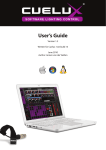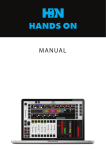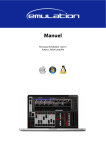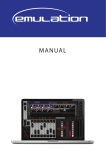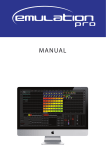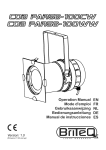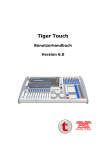Download Emulation User's Guide
Transcript
User’s Guide Version 1.0 Written for Emulation 1.00 October 2009 © 2009 All rights reserved. No parts of this work may be reproduced in any form or by any means - graphic, electronic, or mechanical, including photocopying, recording, taping, or information storage and retrieval systems - without the written permission of the publisher. While every precaution has been taken in the preparation of this document, the publisher and the author assume no responsibility for errors or omissions, or for damages resulting from the use of information contained in this document or from the use of programs and source code that may accompany it. In no event shall the publisher and the author be liable for any loss of profit or any other commercial damage caused or alleged to have been caused directly or indirectly by this document. Due to the dynamic nature of product design, the information contained in this document is subject to change without notice. Revisions of this information or new editions may be issued to incorporate such changes. Products that are referred to in this document may be either trademarks and/or registered trademarks of the respective owners. The publisher and the author make no claim to these trademarks. The Graphics Interchange Format (c) is the Copyright property of CompuServe Incorporated. GIF (sm) is a Service Mark property of CompuServe Incorporated. Emulation User’s Guide Emulation Workflow Welcome to the Emulation User’s Guide. This manual will describe the Emulation software by guiding you through the software. The following diagram explains the workflow of the software: 1 Install the CueCable Driver Page 2 2 Set Options Page 4 3 Create the Patch Page 6 4 Make Groups Page 7 5 Program a Cuelist Page8 6 Modify a Cuelist Page 9 7 Edit a Cue Page 10 8 Playback Assignment Page 11 9 Loading and saving Shows Page 12 10 Globals Page 13 A iPhone Remote Page 14 If, after consulting this manual, you still have questions then you can obtain additional information and help through the online support forum. Emulation users share their experiences and tips on this forum. You can find the forum at http://www.emulationcontrols.com/forum 1 Emulation User’s Guide 1 Install the CueCable Driver Emulation on Mac OS: Just connect the CueCable to a free USB port on your Apple computer and go to “Set Options” on page 4. Mac OS doesn’t need a specific USB driver. Emulation on Windows: please follow this driver installation guide. CueCable Step 1 Step 2 Connect the CueCable to a free USB port on your computer. Click “Locate and install driver software (recommended)” Step 3 Step 4 Click “Don’t search online” Select “I don’t have the disc. Show me other options.” Step 5 Step 6 Click “Browse my computer for driver software” Click “Browse” and select the “drivers” folder in the folder where you’ve installed Emulation (for example “C:\Program Files\Elation\Emulation1003\drivers”). 2 Install CueCable drivers Emulation User’s Guide Step 7 Step 8 Click OK and press “Next”. When this warning appears, click “Install this driver software anyway”. Step 9 Step 10 Windows will install the device driver software. The CueCable driver software is successfully installed! Install CueCable drivers 3 Emulation User’s Guide 2 Set Options Before we start using Emulation, let’s tweak some settings and configure the system. Open the OPTIONS view: You can choose a language for the software’s menus Emulation is updated regularly to provide you with new features, bugfixes and new or improved personality-files. To check for updates, click CHECK NOW Emulation has optimized user-interfaces for several screen resolutions. For example, the 1280x1024 version provides you with 10 extra playback-buttons in 8 banks. For optimal use of the software, select your screen size or select Full Screen. In the previous chapter you’ve learned how to install the CueCable. On the Hardware page, you can check if the CueCable is recognized by the software. TIP: To use Emulation with an external visualizer or to output DMX via a third-party Art-net Node, connect the CueCable to your computer and click ENABLE ART-NET on the Hardware page. At the Hardware page you can change the Art-net universe on which Emulation outputs data. 4 Set Options Emulation User’s Guide To setup Emulation for use with your MIDIcontroller, go to the MIDI page and select the INPUT DEVICE. Select what MAP to use for your MIDI-controller Select the OUTPUT DEVICE for MIDI feedback to the controller Do you want to use a MIDI controller with Emulation that is not displayed in the MIDI MAP list? Then please request the MIDI Map file on the Emulation Forum (http://forum.emulationcontrols.com) and include a link to the usermanual or send an e-mail including the user-manual to [email protected]. We’d be more than happy to create a MIDI Map file for you. Set Options 5 Emulation User’s Guide 3 Create the Patch The PATCH view allows you to setup the DMX fixtures which are connected to Emulation. Click ADD to open the Add Fixture dialog. Browse the manufacturers list, and choose the MANUFACTURER of the first fixture you would like to add. Browse the MODELs for this manufacturer and choose one. If the fixture has several control-modes, you have to choose a MODE. Use the COUNT number to add multiple fixtures Add the fixtures by clicking ADD TIP: Press REMOVE in the Patch view to remove the selected fixtures, keep it pressed for >1 second to remove ALL fixtures. TIP: If a moving light is oriented different from other fixtures, you can compensate by inverting the Pan and Tilt axes or swapping the Pan and Tilt axes of the fixture by selecting the fixture and clicking PROPERTIES. TIP: Would you like to control a fixture with Emulation that is not listed in the personality list? Please request the fixture on the Emulation forum (http://forum.emulationcontrols.com) and include a link to the user-manual or DMXcharts or send an e-mail including the user-manual or DMX-charts to [email protected]. We provide new personality files as a free service. 6 Create the Patch Emulation User’s Guide 4 Make Groups The GROUP menu enables you to create groups with fixtures and or subfixtures. This makes selection of groups or (sub) fixtures easy and allows you to use submasters per group (chapter 8). Add a group with the ADD button Select fixtures in the FIXTURES list Select the new Group and add fixtures to the group by clicking ADD on the right side of the display Click to add all fixtures of the selected type to the group Click “>>” to add the selected fixtures to the group TIP: Have you deleted a group by accident? Click the hardware UNDO button at the left side of the display. Have you clicked UNDO twice by accident? Click REDO to redo. This works for all actions in the software! TIP: The software can automatically create groups for you. Click AUTO CLASS in the GROUP menu and the software will automatically create groups per fixture-type. Click AUTO MODEL and the software creates groups per model. SUBFIXTURES Emulation uses the concept of sub-fixtures. This means that some fixtures consist of multiple sub-fixtures, like a 10-channel dimmer rack is - in our terms - just one fixtures with 8 sub-fixtures. This also works for LED fixtures with multiple segments/pixels. In this manner the maximum of 24 will not be reached that quickly (you can add 24 x 10 = 240 dimmer channels). The reason behind the concept of sub-fixtures is that it makes patching easier; you only add the physical fixtures to your patch and you don’t have to worry about setting starting addresses per dimmer channel, or worse, per LED segment. Make Groups 7 Emulation User’s Guide 5 Program a Cuelist A lightshow in Emulation consists of Cuelists. A Cuelist is a sequence of one or more lighting scenes which are called Cues. To create a Cuelist, follow the next steps. Make sure you’re in the main GRID view. To close any open menu, click the highlighted menu-button again. 1 Select fixtures by clicking them in the GRID view, or use the SELECTION buttons at the bottom left of your screen. Change attributes for the selected fixtures in the Programmer view, for example change the Colour on the Colour page. 2 4 Click RECORD and click the GO button for the playback where you want to create your new Cuelist. Emulation creates a Cuelist with one Cue, assigned to the chosen playback. 3 5 6 Click RECORD and click the same GO button as you used for the previous cue. Emulation now creates a second Cue in the same Cuelist. 7 Change the attributes in the Programmer for the second Cue Now clear the Programmer’s memory by pressing the CLEAR button in the Programmer for >1 second. 8 TIP: To remove an attribute from the Programmer-memory to make sure it will not be recorded in a Cue, press the DELETE button and click the Attribute or Attribute-page in the Programmer to knock it out. TIP: To create a simple chase, you don’t have to record all steps individually. Open the CUE view and press GENERATOR to start the Chase Generator wizard. This is a small built-in tool to quickly generate chase-cuelists! 8 Program a Cuelist Emulation User’s Guide 6 Modify a Cuelist To change an existing cuelist, open the CUE menu. Select a Cuelist and click EDIT to open the Cuelist editor. Here you can edit the properties of the CUELIST. Speed controls the playback speed of the cuelist Select a Cue and click PROPERTIES to change the properties for the selected Cue. Phase-shift controls the offset between fixtures running a shape. TIP: A Cue can have several conditions: Halt: The next cue will not be triggered (cuelist pauses) Wait: The next cue is triggered when this cue starts (when fading starts) Follow: The next cue is triggered when the cue is finished (when fades have finished) TIP: To change a Cuelist into a chase, simply enable CHASE in the Cuelist editor. Now all timing is disabled and the ATTACK fader controls the crossfade between the Cues. The tempo of the chase is connected to the main tempo, which can be changed by the Tempo-controls in the bottom left corner of Emulation: Press BREAK to pause all chases Tap the TEMPO button in the tempo of the music to change the tempo (BPM) TIP: To change the speed of a cuelist while operating a live-show, use the corresponding control fader or rotary on your MIDI control surface or use the scroll-wheel of your mouse while hovering the playback information in the screen directly above the playback. Modify a Cuelist 9 Emulation User’s Guide 7 Edit a Cue To edit a cue: 1 Open the CUE menu 2 Select a cuelist and click EDIT to open the Cuelist editor 3 Select a cue and click EDIT to open the Cue editor There are 3 ways of changing values: Method 1 – In-place edit Double click on a value to edit, this will popup an edit dialog Method 2 – Copy/paste Select a value and press COPY, select another value and press PASTE Method 3 – Via the programmer Press LOAD to load all values of the cue to the programmer. Edit the values using the programmer and the fixture selection, just like when you created the cue. In the CUE editor, press STORE to store the values back from the programmer into the cue. 10 Edit a Cue Emulation User’s Guide 8 Playback assignment To assign cuelists and groups to playback faders and buttons, you can use the PLAYBACK menu. Open it by pressing the PLAY menu button. Switch between managing the playback faders or the playback buttons To clear a playback, select the playback by clicking on the corresponding cell in the table with banks/playbacks. Then click CLEAR To assign a playback to a cuelist, select the playback in the grid and click SET CUELIST. Choose the cuelist you wish to connect and press OK. TIP: When you attach a Group to a playback button, the playback button allows you to quickly select the fixtures in that group. When you attach a Group to a playback fader, the PLAY-button of the playback fader acts as the selection button and the fader becomes a submaster. When the submaster is at 0%, the fixtures in that group will not output any light! TIP: Some cuelists or submasters you will need to change so frequently, that you would like to access them from each bank. You can achieve this quickly by selecting the playback in the table, and clicking BANKSAFE. TIP: To start a cuelist, press the PLAY button of the corresponding playback. To release a cuelist, press and hold the PLAY button of the corresponding playback > 1 second. Playback assignment 11 Emulation User’s Guide 9 Loading and saving Shows The DISK menu allows you to save the current show to a new file or to load an existing show. Click NEW to create a new empty show Open an existing show file by clicking OPEN and selecting a show in the file-browser To save the current show to a new file, click SAVE AS and type a new name. TIP: Emulation automatically saves changes every few seconds. Therefore, manually saving the show is not required. 12 Loading and saving Shows Emulation User’s Guide 10 Globals On the main screen of Emulation, you’ll notice 3 GLOBALS for FOG, STROBE and BLINDER. These buttons can be instantly used without programming individual cuelists. FOG: All fog machines in the configuration will be activated for as long as you keep the button pressed. STROBE: All strobes in the configuration will strobe while keeping the button pressed BLINDER: All fixtures in the group “blinder” will flash at 100% intensity as long as the button is pressed. Because Emulation doesn’t know to which dimmer-channels the blinders have been connected, you have to create a group with the name “blinder” and include the dimmer-channels or fixtures you wish to use. TIP: Would you like to use the FOG global only for a selection of fog machines? Create a group, rename it “fog” and add the fog machines of your choice to that group to have them responding to the FOG global. TIP: Need more strobe-power? Create a group, rename it “strobe” and add fixtures to that group. Don’t forget to add the strobes manually to the strobe-group too! Globals 13 Emulation User’s Guide A iPhone Remote The Emulation Remote allows you to view the patch including addresses and dipswitch settings per fixture in real-time from your iPhone, and it even allows you to trigger the playback-buttons remote! To use the Emulation Remote on your iPhone, follow the next steps. Make sure the computer running Emulation and your iPhone are connected via WIFI (for example via a simple WIFI router as displayed. In Emulation, go to Options -> Remote and enable “’Enable Remote Control”. On your iPhone, browse to the address displayed in Emulation. Finished! 14 iPhone Remote

















